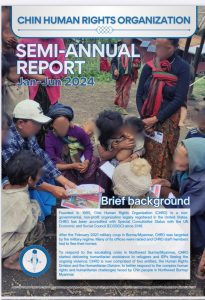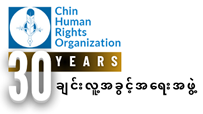What prompted our Humanitarian Action?
Following the 2021 military coup in Myanmar, the Chin people have faced severe human rights abuses, mass displacement, and a growing humanitarian crisis. CHRO recognized that addressing the immediate needs of the Chin people—such as food, shelter, and healthcare—required more than just traditional relief efforts. It demanded a response grounded in the protection of their fundamental rights.
CHRO intervened in this crisis to fill the gap left by international actors who faced restrictions or were unable to reach the hardest-hit areas in Chin State. The organization’s deep connection to the local communities, understanding of the conflict dynamics, and expertise in documenting rights abuses positioned CHRO to deliver humanitarian assistance while advocating for the protection and dignity of the Chin people. By integrating human rights into its humanitarian response, CHRO ensures that aid is not only a lifeline for survival but also a tool for empowerment and justice.
The Humanitarian Division
The Humanitarian Division was created to provide life-saving assistance to Chin communities facing crisis while ensuring that their fundamental rights are protected, recognizing that humanitarian aid must be delivered with a focus on dignity, safety, and long-term justice. To provide effective and streamlined response to the complex humanitarian needs inside Chin State and along the India-Myanmar/Burma border, the Division was divided into two units:

First half year report (2024)
The Emergency Response and Community Resilience Unit provides rapid, life-saving assistance to communities affected by conflict and displacement, while building their capacity to withstand future crises. This unit focuses on immediate relief, such as food, shelter, and essential supplies, while fostering long-term resilience through community-led initiatives.
The Health and Protection Unit ensures access to essential healthcare and safeguards vulnerable populations, particularly women, children, and the elderly. It addresses critical health needs and promotes protection from violence and exploitation, integrating a rights-based approach into all aspects of humanitarian assistance.
CHRO’s rights-based approach to humanitarian action is rooted in the belief that humanitarian assistance and human rights advocacy are inherently connected. This approach ensures that humanitarian responses prioritize the dignity, safety, and rights of those affected, especially the most vulnerable populations, such as women, children, and other minorities.
This rights-based approach allows CHRO to tackle both the immediate humanitarian needs and the underlying issues of injustice, exclusion, and repression that have worsened the crisis. Through this work, CHRO aims to protect the Chin people’s rights, build resilience, and lay the groundwork for long-term justice and accountability.
The Humanitarian Action Strategy

CHRO’s rights-based humanitarian action strategy is built around four core pillars: Respond, Mitigate, Strengthen, and Rehabilitate. These components ensure that CHRO’s humanitarian efforts are not only immediate but also sustainable, focusing on the protection of human dignity and rights, especially for vulnerable and conflict-affected communities.
- Respond: CHRO’s first priority is to provide immediate, life-saving assistance in the wake of crises. Whether the crisis involves natural disasters, conflict-induced displacement, or humanitarian emergencies, CHRO’s rapid response involves mobilizing resources, coordinating relief efforts, and delivering aid to affected communities. CHRO responds with a rights-based approach, ensuring that humanitarian interventions respect the rights and dignity of those in need. This involves prioritizing marginalized and hard-to-reach communities, as well as advocating for the protection of civilians in conflict zones.
- Mitigate: To reduce the risks and impact of future crises, CHRO works to address the root causes of vulnerabilities, such as discrimination, exclusion, and systemic inequalities. Mitigation efforts include advocacy for stronger protection mechanisms, improving access to essential services, and empowering local communities with the knowledge and tools to better withstand future shocks. CHRO also collaborates with local and international actors to promote policies that mitigate the effects of crises and ensure that humanitarian assistance reaches those most in need, without discrimination.
- Strengthen: CHRO believes that sustainable humanitarian work must involve strengthening local capacities. This includes building the resilience of communities by supporting local civil society organizations (CSOs), community-based organizations (CBOs), and grassroots networks. CHRO’s capacity-building initiatives equip local actors with the skills and resources needed to manage crises effectively, protect human rights, and foster community cohesion. By strengthening local capacities, CHRO ensures that communities are not only recipients of aid but also active participants in their recovery and long-term resilience.
- Rehabilitate: The final pillar of CHRO’s strategy focuses on the long-term rehabilitation and recovery of affected communities. This involves more than rebuilding infrastructure; it includes restoring livelihoods, supporting mental and physical health, and ensuring that communities have access to education, legal assistance, and opportunities for social and economic reintegration. CHRO’s rehabilitation efforts are guided by the principles of justice and accountability, ensuring that survivors of human rights abuses receive the necessary support and recognition. This approach also seeks to address the structural inequalities and rights violations that contributed to the crisis in the first place, laying the groundwork for sustainable peace and development.
Together, these four pillars form the basis of CHRO’s rights-based humanitarian action, ensuring that its interventions are comprehensive, inclusive, and grounded in the principles of human dignity and rights. Through Responding to emergencies, Mitigating future risks, Strengthening local capacities, and Rehabilitating affected communities, CHRO aims to create a more resilient and rights-respecting environment for those it serves.
